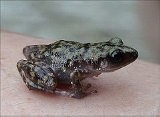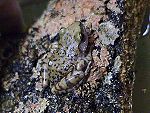
Eleutherodactylus marnockii
Encyclopedia
The Cliff Chirping Frog (Eleutherodactylus marnockii) is a small Leptodactylid
frog
found in the United States
, in central and western Texas
.
or tan
in coloration with brown
or black
mottling, often with banding on the rear legs. They have a somewhat flattened body which allows them to hide in rock crevices. They have no or little webbing between their toes.
and live most of their lives on limestone
rock faces, often near emerging springs. Like most frogs, they will hop, but they are also capable of crawling, which aids them in hiding in rock crevices. Though primarily found around rocky areas, they are also common in forested regions, any area with a moderate amount of moisture, but isn't actually a pool of water or stream. Their primary diet is small insect
s.

a year, in a moist substrate of leaf litter, or soil.
Leptodactylidae
Leptodactylidae is a diverse family of frogs that probably diverged from other hyloids during the Cenozoic era, or possibly at the end of the Mesozoic. There are roughly 50 genera, one of which is Eleutherodactylus, the largest vertebrate genus, with over 700 species...
frog
Frog
Frogs are amphibians in the order Anura , formerly referred to as Salientia . Most frogs are characterized by a short body, webbed digits , protruding eyes and the absence of a tail...
found in the United States
United States
The United States of America is a federal constitutional republic comprising fifty states and a federal district...
, in central and western Texas
Texas
Texas is the second largest U.S. state by both area and population, and the largest state by area in the contiguous United States.The name, based on the Caddo word "Tejas" meaning "friends" or "allies", was applied by the Spanish to the Caddo themselves and to the region of their settlement in...
.
Description
Cliff frogs are 0.75 to 1.5 inches in length, and are an olive greenGreen
Green is a color, the perception of which is evoked by light having a spectrum dominated by energy with a wavelength of roughly 520–570 nanometres. In the subtractive color system, it is not a primary color, but is created out of a mixture of yellow and blue, or yellow and cyan; it is considered...
or tan
Tan (color)
Tan is a pale whiteish, tawny shade of white. The name is derived from tannum used in the tanning of leather.The first recorded use of tan as a shade name in English was in the year 1590....
in coloration with brown
Brown
Brown is a color term, denoting a range of composite colors produced by a mixture of orange, red, rose, or yellow with black or gray. The term is from Old English brún, in origin for any dusky or dark shade of color....
or black
Black
Black is the color of objects that do not emit or reflect light in any part of the visible spectrum; they absorb all such frequencies of light...
mottling, often with banding on the rear legs. They have a somewhat flattened body which allows them to hide in rock crevices. They have no or little webbing between their toes.
Behavior and habitat
Cliff chirping frogs are nocturnalNocturnal animal
Nocturnality is an animal behavior characterized by activity during the night and sleeping during the day. The common adjective is "nocturnal"....
and live most of their lives on limestone
Limestone
Limestone is a sedimentary rock composed largely of the minerals calcite and aragonite, which are different crystal forms of calcium carbonate . Many limestones are composed from skeletal fragments of marine organisms such as coral or foraminifera....
rock faces, often near emerging springs. Like most frogs, they will hop, but they are also capable of crawling, which aids them in hiding in rock crevices. Though primarily found around rocky areas, they are also common in forested regions, any area with a moderate amount of moisture, but isn't actually a pool of water or stream. Their primary diet is small insect
Insect
Insects are a class of living creatures within the arthropods that have a chitinous exoskeleton, a three-part body , three pairs of jointed legs, compound eyes, and two antennae...
s.

Reproduction
Breeding occurs year round, except at the coldest points of the winter, but generally peaks during the rainy season in the months of April and May. Females can lay up to three clutches of eggsEgg (biology)
An egg is an organic vessel in which an embryo first begins to develop. In most birds, reptiles, insects, molluscs, fish, and monotremes, an egg is the zygote, resulting from fertilization of the ovum, which is expelled from the body and permitted to develop outside the body until the developing...
a year, in a moist substrate of leaf litter, or soil.

